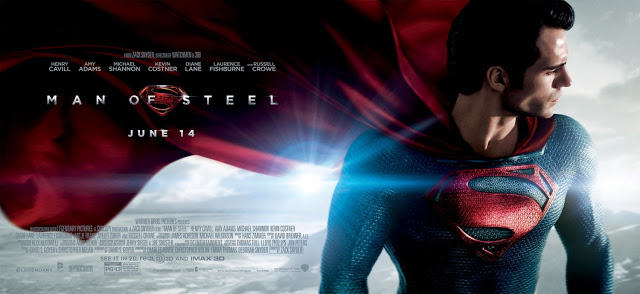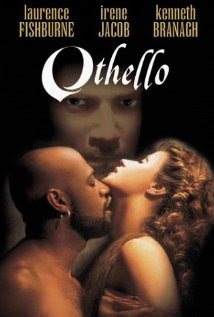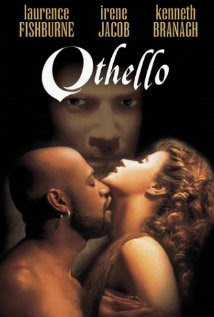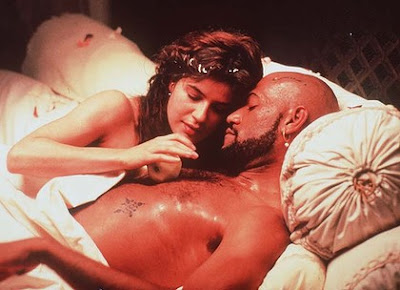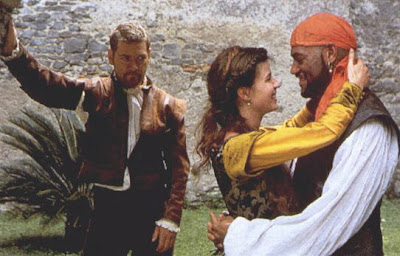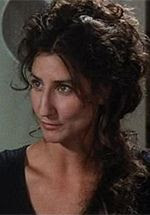 |
| Movie poster for Man of Steel |
Amy Adams is amazing as Lois Lane in
Man of Steel. Her version of Lois is fearless, witty and wise. Diane Lane and Ayelet Zurer as the respective mothers of Superman are also amazing, as is the fact that both Superman’s Kryptonian mother, Lara Lor-Van (played by Zurer), and his human mother, Martha Kent (played by Lane), are displayed as equal partners with equal power and say to his two fathers. Further, not only are the heroic females strongly played and given substantial dialog, but so, too, is the lead female villain, Faora-Ul (Antje Trau), second-in-command to the Kryptonian General, given just as much screen time, dialogue, and power (if not more) than Zod, the Kryptonian super-villain played by Michael Shannon.
 |
| Michael Shannon as General Zod in Man of Steel |
In general,
Man of Steel, the latest film iteration of the Superman story, conveys that women are just as key to the Superman narrative as men. This is true from the opening moment, when the birth scene of baby Kal-El, who will grow up to be Superman/Clark Kent, focuses on his mother Lara. Then, the decision to send their child to earth is equally shared by Lara and Jor-El (the Kryptonian scientist played by Russell Crowe). Once the movie shifts to the young Clark’s life on earth, his human parents, Martha and Jonathan Kent (Lane and Kevin Costner), are again equally featured. Lane is particularly strong as Martha, saving Clark from the monsters in his own head in an early scene, and later supporting him as he struggles with what the revelation of his identity has wrought. Part of the consequence of this revelation is the destruction of her home—but the only thing she worries about salvaging is the photo albums, telling Superman not to worry about the house, that “it’s only stuff.”
All of this may seem relatively minor, but it is rare for superhero movies to feature females in important, non-sexualized, non-damsel-in-distress roles (as recent articles and Twitter buzz has focused on, particularly in relation to the fact there is still no Wonder Woman movie). It is rare to depict women as non-materialistic and wise, not to mention portraying mothers as being alive (especially in Disney films!), let alone being as important as fathers are. As such, I had planned to focus on the females in the film for my review.
 |
| Henry Cavill, Amy Adams, and Antje Traue in Man of Steel |
Alas, after looking up the cast of the film on IMDB in order to write this review and coming across the image of the young boy who plays 9-year-old Clark Kent (Cooper Timberline) posing with arms bent on hips, a stern look on his face and a cape flowing out behind him—an image that smacks of muscular masculinity—I was consumed by the image of my own son, age three or thereabouts, running around the house endlessly in his Superman costume. This, coupled with two very young boys who sat in front of me at the screening, astride their mother’s lap, asking questions like “Why isn’t Superman flying?” and “Where is Superman’s cape?” got me thinking: How does the iconic image of Superman shape young boys’ concepts of masculinity? And, given that Superman is generally viewed as the ideal super-hero model for boys (less dark than Batman, less conflicted than Spiderman, more memorable and enduring than Iron Man, Aquaman and so on), what does this new movie deliver in terms of modeling “super masculinity”?
 |
| Cooper Timberline as a young Clark Kent in Man of Steel |
On the one hand, there are many positives. The film questions hyper-masculinity, militarism and other power-over models, or the reliance on brawn over brains. It condemns the sexual objectification of women, macho bravado and the bullying aspects of male culture.
On the other, though it is critical of hyper-masculinity and the violence it engenders, the film’s extended action-and-explosion-packed ending undercuts this critique. At the level of content, the film offers a feminist-friendly version of Superman, but its visuals—especially the extended fight scenes between Superman and Zod (which dominate the last 45 minutes or so)—contradict this narrative. The content says “Women and men are equally important and violence/domination is bad for everyone” but the visuals say “Let’s blow shit up and watch dudes punch each other through buildings!!”
 |
| Still from Man of Steel |
Back to the positives, the film not only condemns sexual objectification and harassment of women, or the ways in which traditional masculinity harms women, but also denounces men’s bullying of and violence toward one another—the ways in which traditional masculinity also harms
men. Near the start of the film, when a man slaps a waitress’ butt, Clark, working as a busboy, intervenes, calling out the man for his inappropriate behavior. The man then goads Clark with a “what are you gonna do about it” attitude, dumping a beer over his head. The other men at the bar snigger in approval. Rather than resorting to violence, though, Clark walks away. Similarly, later in the film, in a flashback to when Clark was in middle school, a group of boys attack him, prodding him to fight back, but he refuses. Again, the males act in pack fashion, spurring one another to be violent and criticizing those who do not “live up” to the violent ethos of being a “real” man.
The central male characters who champion violence are also rebuked in the film, but none more so than Zod for his imperialistic, genocidal and militaristic goals. The film deserves props here for showing that women can not only be just as good as men, they can also be just as bad as them—exemplified by Zod’s second in a command, a woman. In so doing, it de-genders violence, showing that it is not inherently male but rather that the power-over mentality is the problem, not the gender of the person who buys into it. The weapon-happy stance of the military is also reproached, as when Colonel Nathan Hardy (Christopher Meloni) calls for his soldiers to shoot at Superman, or when General Swanwick (Harry Lennix) is rebuked for sic’ing a surveillance drone on Superman (a very timely rebuke indeed!)
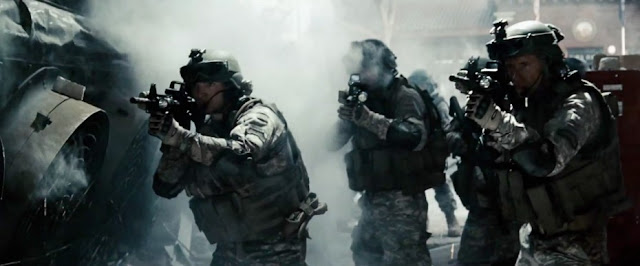 |
| Soldiers in Man of Steel |
In contrast to these power- and weapon-happy males, the film offers various representations of a kinder, gentler, more positive masculinity via Jor-El and Jonathan Kent, Superman’s two fathers. Both of these figures encourage Clark/Superman to act with integrity and empathy. Framing him as “the bridge between two worlds,” these fathers insist that Clark/Superman can “embody the best of both worlds” and bring a message of hope that insists “every person can be a force for good.”
Here, the film circulates around the fear of difference in ways that nod to the narrative that arguably undergrids the original comic—a narrative that has been read as criticizing racism and, in particular, anti-Semitism. The author, much like Clark in various iterations of the story, was bullied as a kid, and the original comics were penned during the years preceding World War II and the rise of the Nazi party in Germany. Thus it’s not a stretch to read Superman as a racialized underdog hero, an “alien” who is despised for his difference. His Kryptonian mother’s comment at the outset of the film underscore this reading. She worries that Kal (Clark’s Kryptonian name) will “be an outcast, a freak” on earth. His human parents share similar fears, encouraging him to hide his difference, to “pass” as human. But partway through the film, Kal/Clark sheds his closeted identity in order to save earth and its inhabitants.
 |
| Henry Cavill as Superman |
In a pivotal scene, he confronts the military brass who have handcuffed him upon the discovery of his “alien-ness,” saying, “You’re scared of me because you can’t control me.” Here, a bevy of connotations arise—how violence is about control, how difference is controlled through violence so that those in power can maintain their power, how viewing difference as an alien threat leads to violence. But, as Superman insists, the inability to control him does not make him an enemy. (U.S. government and military leaders please take note: Just because we cannot control what other countries do, this does not make them our enemy.)
Here and elsewhere, this version of the Superman story questions the way in which power-over mentality, coupled with hyper-masculine bravado, will lead to planetary ruin. Metaphorically, the film questions the reliance on brawn (embodied by Zod and the military brass) over brains (embodied by Jor-el) and heart (embodied by Superman). Further, the Krypton/Earth binary can be seen as emblemmatic of traditional notions of male and female, with the powerful Krypton threatening to control and/or annihilate Earth. Instead of maintaining these dichotomies, the film suggests that both Kryptonians and humans, males and females, can be a “bridge” to a better world. The movie also takes pains to depict Lois and Superman as a team, rather than as a savior and his damsel in distress. This is particularly underscored near the end of the film when someone looks on at the pair after the near destruction of earth, and says “THEY saved us” not “He saved us” or “Superman saved us.”
Lois is depicted not only as a fearless, intrepid investigative journalist, but also adept at figuring out Kryptonian ships and carrying out plans of escape/survival. Near the end of the film, she tells Superman, “I know how to stop them” (Zod and company). As such, she is as much superhero as he, though she is human and he is super-human. To make her even more amazing, she is clearly cognizant of hyper-masculine posturing, as when she is waiting to be shown a Russian submarine the military thinks they have found and says to the brass, who are verbally trying to out-macho each other, “If we are done measuring dicks…can you show me what you found?”
 |
| Laurence Fischburne and Amy Adams in Man of Steel |
On the less positive side, Superman, as the personification of “super masculinity,” is—as indicated by the reboot title—a hyper-muscular man of steel. His moniker suggests he is hard, unbreakable, impervious and made of muscle—notions that mesh well with the unattainable ideal of masculinity currently in circulation and which are embodied via his excessively built form. Though he uses his strength for good and resorts to violence only as a last resort, the overly-long excessive fight scene between he and General Zod contradicts the earlier narrative claims the movie makes regarding violence, militarism and power. If these things are bad (as the first three-quarters of the film suggests) why do we need to watch scene after scene of he and Zod punching each other, destroying buildings and displaying their uber-strength? Why was it necessary to destroy multiple buildings, cars, planes, semi-trucks, satellites and so on in a way that makes Spock’s overly-long fight scene with Khan in the recent
Star Trek: Into Darkness seem short by comparison?
My sense is that those in charge of filming, editing and special effects were loathe to cut these visually arresting scenes. Which reminds me of some comments I heard walking out of the film: “I feel like I am on sensory overload,” “I feel like my senses have been assaulted,” and “After all those explosions, I think I lost some hearing.” As these comments suggest, these action scenes can in themselves be viewed as a form of assault on the audience—one that, admittedly, certain audiences crave—but one that nonetheless suggests that the way to be “super” (as a man or a film) is to be violent, to blow shit up, to be stronger than the other guy/gal.
 |
| Laurence Fishburne during some explosions in Man of Steel |
As the fight scenes dragged on and on, the two young boys in front of me stopped squirming in their seats and stared at the explosive images on the screen—images that screamed the only way to “win” and be “super” is via violence and weaponry, or have a body that is itself a weapon. This is not the image I hold of my son running around in his Superman costume at age 3, nor of his smiling, dimpled face and curly-haired locks in his kindergarten picture (in which he’s wearing a Superman t-shirt). No, that boy liked the idea of flying, not killing. But with so many images that teach boys (and girls) that to be a “super-male” is to be one capable of violence, how can we expect our boys to soar in ways that promote messages of hope, inclusivity and an insistence “every person can be a force for good”?
I don’t have the answer. But I do know that my now-16-year-old-son, who attended the screening with me, had a key complaint about the film: “The fight scenes were way too excessive.” If a teenager raised in a culture that champions such scenes as “the stuff great blockbuster movies are made of” gets this, why the heck can’t Hollywood?
Natalie Wilson, PhD is a literature and women’s studies scholar, blogger, and author. She teaches at Cal State San Marcos and specializes in areas of gender studies, feminism, feminist theory, girl studies, militarism, body studies, boy culture and masculinity, contemporary literature, and popular culture. She is author of the blogs Professor, what if …? and Seduced by Twilight. She is a proud feminist mom of two feminist kids (one daughter, one son) and is an admitted pop-culture junkie. Her favorite food is chocolate.









